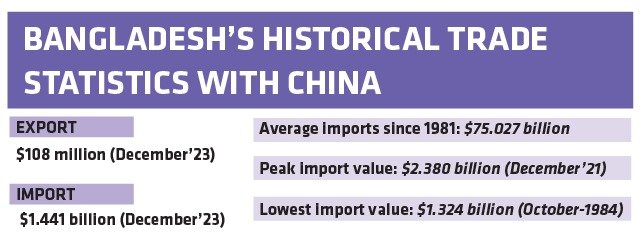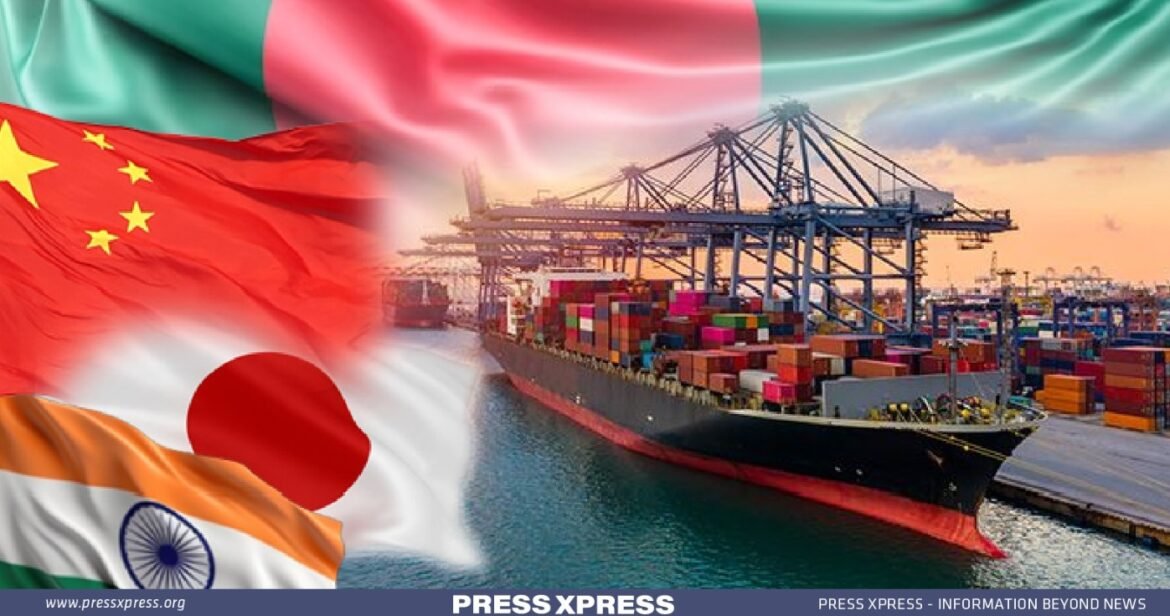In the vast landscape of global trade, Bangladesh is crafting a masterpiece of trade deals and diplomatic bonds that steer its economic journey. With free trade agreements (FTAs) inked with economic powerhouses like Japan, China, and India, Bangladesh charts a course towards expanded trade horizons and fortified diplomatic relations.
The seeds of collaboration between Japan and Bangladesh were sown in 2022, as both nations embarked on a journey of exploration, delving into the prospects of an Economic Partnership Agreement (EPA). Beyond mere economic transactions, this endeavor seeks to foster deeper ties, transcending borders to nurture a climate of mutual prosperity and understanding.
You Can Also Read: Social Safety Nets Program, A Hope for the Vulnerable!
Meanwhile, the burgeoning partnership between Bangladesh and China paints a portrait of potential and promise. As the world’s second-largest economy, China beckons as a fertile ground for Bangladesh’s trade expansion efforts. The exchange of draft feasibility study reports signals the dawn of a new chapter, as both nations navigate the complexities of forging an FTA. With a joint working group poised to convene in Dhaka, the path toward finalization is paved with anticipation and ambition, promising to unlock untold opportunities for both parties.
Amidst these diplomatic maneuvers, India emerges as a cornerstone of Bangladesh’s trade landscape. Despite a trade surplus that tilts in India’s favor, valued at $12.21 billion in exports against $2.02 billion in imports, the specter of imbalance looms large. The call for vigilance from organizations like CUTS underscores the delicate balance between regional cooperation and safeguarding national interests. In navigating these waters, Bangladesh treads cautiously, mindful of fostering economic cooperation while safeguarding its own interests.
Bangladesh-Japan EPA and India’s Trade Landscape
India finds itself at a crossroads, poised on the precipice of transformative trade dynamics. While Bangladesh and Japan dance towards the climax of an Economic Partnership Agreement (EPA) set to be inked by December 2025, promising a symphony of strengthened economic bonds and the allure of duty-free market access for Bangladesh, a shadow looms over the horizon.
As Bangladesh reaches out to Japan, seeking to strengthen trade ties, a report from CUTS International casts a shadow of caution over India. In this moment of uncertainty, it serves as a gentle reminder to tread carefully amidst the excitement.
India stands as Bangladesh’s second-largest import partner, just behind China, painting a vivid picture of their economic interdependence. In the fiscal year 2021–22, Dhaka exported goods worth $1.990 billion to India, while importing goods valued at $13.69 billion from the same source.
Fast forward to the fiscal year 2022–23, up until February, Indian exports to Bangladesh soared to $10.63 billion, representing 2.6% of India’s total exports. Conversely, Bangladesh’s imports from India during this period amounted to $1.86 billion, comprising 0.28% of India’s overall imports.
As the wheels of Bangladesh-Japan FTA talks gain momentum, CUTS issues a clarion call to vigilance. India must fortify its defenses, safeguarding its trade interests while nurturing the seeds of regional economic cooperation.

In the marketplaces of Bangladesh, a tapestry of commerce unfolds – distillation products, mineral fuels, vegetables, cereals, fabrics, ferrous products, vehicles – each a thread in the fabric of Indo-Bangladeshi trade. Yet, Japan’s exports, though sparse, bear witness to the diversity of commerce – base metals, vehicles, machinery – each a testament to the mosaic of global exchange.
Bangladesh-China FTA Draft Exchange Signals New Era
In the world of diplomacy, Bangladesh and China waltz in a graceful exchange of drafts, each step drawing them closer to a harmonious partnership. With a draft feasibility study report on a Free Trade Agreement (FTA) between them, the stage is set for a transformative journey in their economic relationship.
Soon, a joint working group will convene in Dhaka, tasked with expediting the finalization of this feasibility study. Within the hallowed halls of the Ministry of Commerce, officials gather for a ceremony, where the exchange of reports becomes a symbolic gesture of intent.
Amidst the solemnity of the gathering, Commerce Secretary Tapan Kanti Ghosh casts his mind back to a memorandum signed during the visit of the Chinese president to Bangladesh in 2016. A seed planted then has blossomed into the joint working group, tasked with nurturing the fertile soil of possibility. Despite the disruptions wrought by the Covid-19 pandemic, the wheels of progress have continued to turn, culminating in the exchange of the draft feasibility study report.
In December 2023, Bangladesh welcomed goods worth $1.441 billion from China, a slight increase from the previous November’s $1.380 billion. Over the decades, Bangladesh’s imports from China have averaged around $75.027 billion since 1981. December 2021 witnessed a peak of $2.380 billion, while the lowest recorded import value was $1.324 billion in October 1984.
However, in December 2023, China received $108 million worth of goods from Bangladesh.

The statistics paint a stark picture of Bangladesh’s trade landscape. China looms large as the largest source of imports, a behemoth whose influence dwarfs all others. Yet, amidst the tide of imports, Bangladesh’s exports to China struggle to gain traction, despite the promise of duty-free access for the majority of products.
China and India have emerged as linchpins in Bangladesh’s trade ecosystem, their significance underscored by their contribution to over 40% of the country’s total imports. Intermediate and capital goods flow from these nations, fueling Bangladesh’s economic engine, albeit at a cost.
Bangladesh and Japan Forge Economic Alliance with EPA Talks
Bangladesh and Japan are charting a new course with the start of talks for an Economic Partnership Agreement (EPA) by 2026. This bold move underscores Dhaka’s aim to attract significant investment from Japan’s robust economy while securing its duty-free export benefits after graduating from least developed country status.
The momentous declaration unfolded at a joint press conference held at the Ministry of Commerce in Dhaka, where State Minister Ahasanul Islam and Japanese Ambassador Iwama Kiminori unveiled this transformative pact.
Japan stands as one of Bangladesh’s paramount trade and investment allies. However, the imminent cessation of duty-free access following Bangladesh’s graduation poses a formidable challenge, with potential average tariffs of 18% looming over exports to Japan.
Amidst this backdrop, Bangladesh’s exports to Japan burgeon exponentially, underscoring the urgency for a comprehensive trade framework. With shipments soaring to $1.9 billion in the last fiscal year, and imports scaling to $2 billion, the economic symbiosis between the two nations is vividly evident.
The fabric of economic collaboration is woven further by the presence of over 300 Japanese firms investing in Bangladesh, though the total foreign direct investment from Japan since independence remains modest at $3 billion.
A beacon of hope shines with the establishment of the Japanese Economic Zone in Narayanganj’s Araihazar, projected to draw a staggering $1.6 billion in investments. Furthermore, Japan’s commitment to the Matarbari deep-sea port signals a transformative influx of approximately $100 billion, heralding a new era of economic prosperity for Bangladesh.

In the realm of diplomacy, Ambassador Iwama Kiminori articulated the shared vision of the two nations, emphasizing the impending EPA negotiations as a gateway to enhanced trade, streamlined investment avenues, and the removal of trade barriers.
With the EPA inked into reality, Bangladesh sets its sights on a strategic alignment of 13 pivotal sectors, beckoning Japanese industrial giants to embark on a journey of collaboration and growth. “Japan is not merely a partner; it is our strategic ally,” declares Ahasanul Islam, underscoring the profound bonds forged through shared endeavors such as the Matarbari deep-sea port and the Dhaka metro rail.


